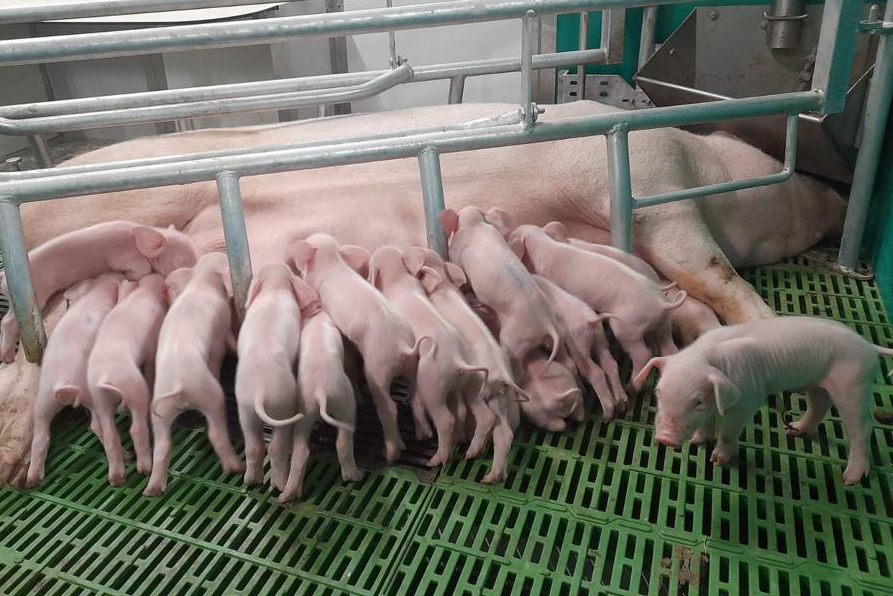At 10%, agriculture is responsible for a fairly small share of greenhouse gas emissions in the UK. Two-thirds of these come from livestock farming, and methane emissions account for the majority. So, we pig farmers are out of the picture for now? Because pigs do not produce methane? Or because one could argue that the UK agriculture accounts for less than 0.00000002 per mille of global emissions? So, we’d better concentrate on more obvious challenges? Not at all …
Every kg counts …
This sentence does not only apply when you look at the scales and your trousers pinching. It applies in so many areas, especially in agriculture and pig farming. Just as every extra kilo of feed consumed reduces your wallet, which is also infinitesimal compared to the sum of the world’s “wallets”, every kilo of emissions also counts.
Even if farmers do not (yet) have to pay levies on greenhouse gas emissions or buy CO2 certificates to be allowed to produce, it is only in the sense of sustainable, future-oriented and at the same time economically successful pig production to think about this aspect at an early stage and to set up one’s farm accordingly.
What approaches can be successful in pig production?
In addition to the areas of energy (e.g., use of renewable energies), structural adaptations (e.g. storage of farm manure), feed plays an essential role in pig farming. On the one hand, it is about the procurement of feed (international vs. regional) and on the other hand about the costs. Around 65% of the costs incurred in the production of pork are costs for feed.
Good animal health and welfare also make themselves felt in the carbon footprint through fewer losses. Fewer resources, including labour, are needed, since the lost animal has also eaten – and usually less efficiently than its colleagues – and created labour – and usually more than its pen mates.
Breeding for efficiency and health
At the globally active Genus plc, the parent company of PIC (pig breeding) and ABS (cattle breeding), sustainability plays an extremely important role. Sustainable production of animal food (protein) starts with breeding. At Genus, they are convinced that genomic methods in animal breeding offer the most cost-effective way to reduce greenhouse gas emissions. Therefore, the approach focuses not only on continuous improvement of performance, but also on improved animal health (e.g. PRRS resistance) and fitness to climatic challenges, which can reduce the need for antibiotics and veterinary care.
Breeding progress for sustainability and economy
PIC genetics has always stood for efficient pig production. This becomes particularly clear when we look at the composition of the breeding indices for the dam and sire lines.

And when we look at the PIC products on the market here, we see this put into practice:
The Camborough® requires less feed than other genetics, is ready for breeding earlier, raises its own piglets, is robust and long-lived and produces more piglets (and thus meat) in its lifetime.
PIC’s terminal sires ideally complement the Camborough®, but also help to produce vital, fast-growing fattening piglets with other sow genetics.
The PIC®380, combines the Industry Leading Boar for Profit Potential – PIC®337 – with the Advanced PIC®800. Delivering FCR at heavy weight with ease of management through the production chain.
The PIC®800 is PIC’s Duroc. With it you get everything you expect from a Duroc of Danish origin: lots of growth, high meat size, good robustness and in addition more efficient feed conversion, fewer losses, and better meat quality.
With the PIC327®, the most efficient lean production sire. This offers excellent lean gain at heavy weights, along with robust growth and low backfat.
This illustrates once again that efficient and economical pig production also means sustainable pig production. This requires the right approach at a very early stage in order to align research and development accordingly. This is because trend-setting decisions, e.g., breeding for resistance or resilience, have to be made in the very long term.
Setting and reviewing sustainability goals
Genus, PIC’s parent company, sets measurable targets every year in its sustainability efforts, including the reduction of greenhouse gas emissions. These targets refer to the amount of greenhouse gas emissions generated throughout the life cycle of an animal and directly related to the breeding process.
To quantify this reduction, the factors that influence each animal’s carbon footprint, including the efficiency with which feed is converted into meat and milk and other health-related characteristics, are continuously assessed.


These targets are documented in the Genus Sustainability Report. For the 2021/22 marketing year, a reduction of 3.57 kgCO2eq (carbon equivalents) per slaughter pig significantly exceeded the set reduction target of 2.22 kgCO2eq. And this could be achieved with the traits, weightings and breeding objectives that are in focus anyway, i.e., without explicitly selecting for “carbon footprint”. What if the breeding index were geared towards a positive climate balance?
In total, the breeding progress for 2021/22 means an annual reduction of 678,300 tonnes CO2eq, as a result of pig producers worldwide using PIC genetics.
- in the Genus Annual Report
- • in the Genus Sustainability Report
- at Genus plc | Sustainability
To return to the question posed at the beginning: What does breeding progress contribute to improving the carbon footprint: Even if the contribution of an individual animal or farm may seem small, breeding progress in aggregate means an important contribution to improving the carbon footprint.
Contact your PIC representative to learn more about the efficiency of PIC genetics.




